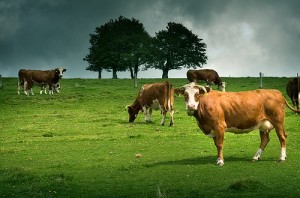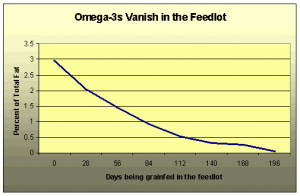The Startling Truth About Grass vs Grain Fed Meat

You’ve heard all the hype (and well-founded hype it is) about omega-3, and you know what you should be doing to add more of this essential fatty acid into your diet, but it’s sometimes easier said than done, isn’t it? After all, there’s only so much salmon and oily fish a person can eat besides which – as good as your intentions are, and as powerful as a good quality omega-3 supplement can be – you don’t always remember to take your capsules. Of course you could always up your intake of certain green vegetables, of eggs and walnuts, but who can say whether it adds up to enough of the stuff?
According to strength/conditioning coach and hormone expert Charles Poliquin, you need between 35-40 grams of omega-3 every day. A typical salmon steak has less than 5 grams, so even if you’re not concerned about mercury and genetically modified or farmed fish, the reality is that your diet is most likely lacking in this important fat. And whether you’re after weight loss, greater mental acuity, healthy cell and hormone development, or just plain old better health and energy the truth is that if you’re not getting enough you’re selling yourself quite quite short.
But here’s the good news.
Did you know that there’s a source of omega 3 you probably haven’t even heard of? One that tastes fantastic, is easy to access, and comes with a host of other big health bonuses? I’m talking about grass fed beef, along with other grass fed red meats (lamb, game meat, wild meat – although that could be harder to access). Typical store-bought meat, unless it specifically states otherwise and is certified by a trusted organic food board, is not only factory farmed (an abhorrent process that causes me to in part agree with those who don’t eat meat) but is raised predominantly on grains and soy.
This is a huge problem in that cows and other land animals are a) not designed to eat foods other than grass, and b) often end up ill and covered in sores due to this unnatural diet. Hence the prevalence of antibiotics and hormones in conventionally farmed meats. It doesn’t take more than a little common sense to realize that the residues of these toxins are making their way into our bodies if we choose to eat these animals – and what’s more, your body protects you by stuffing them into your fat cells, which causes them to expand. But as if that weren’t bad enough, meat from animals raised on grains has been found to be high in inflammatory omega-6 fatty acids, and low in omega-3 fatty acids.
Data from: J Animal Sci (1993) 71(8):2079-88.
So why don’t the farmers just feed them grass?
- Grain and soy are both super cheap food sources – especially those grains deemed not fit for human consumption
- Eating this way fattens them up far quicker than a grass-based diet
- It doesn’t require lots of expensive land
- The typical consumer has no idea how important it is to eat grass fed meat, and probably doesn’t know or care how their food has been raised
- The food and restaurant industry even supports the rearing of grain-fed meat by highlighting it as a good thing on many fine-dining menus!
It’s already quite obvious how meat from grass fed animals is better both for the animal and for your body. The chart above, if you consider it in reverse, shows quite clearly how the longer an animal is reared on grass, the higher its levels of omega-3. By definition, this meat also will contain a lower amount of omega-6, which is present in most vegetable oils such as corn, sesame, soy, sunflower and safflower, and is typically overeaten in our western diets. Furthermore, grass fed meat has far greater levels of conjugated linoleic acid (CLA), a fairly recently discovered good fat which, in its natural form, has been shown to fight off cancer, promote fat loss, and assist in lean muscle gain. CLA all but disappears in meat raised purely on grain and soy.
So how to access this all-important fat and protein source?
As mentioned earlier, it’s not usually as simple as hitting your local store or even the market. And good luck asking your butcher which of their meats are grass fed – I’ve found most look at me blankly (which I find truly shocking). I buy all my meat, eggs, and dairy organically, knowing that organic meat is, by definition, typically free-range and reared according to nature. Unfortunately, however, it’s no guarantee, which is another reason you must always source certified organic foods, and – when it comes to meat – check to be sure it’s grass-fed. Some of the best places for organic meat include farmers markets (do a Google search to see what’s on in your area), specialist organic butchers (again, you’ll need to search), and occasionally you’ll find an organic butcher at a regular market.
It’s true that it does take more effort to eat this way, but I’d say it’s a helluva lot greater inconvenience to deal with the long-term health and weight consequences of poor dietary choices.
Wouldn’t you?


This is a nice blog i must say, usually i don¡¯t post comments on others¡¯ blogs but would like to say that this post really forced me to do so!
Thanks!